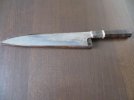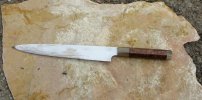Performance versus fit and finish... Well these two aren't mutually exclusive of course.
I will say that as a kitchen knife enthusiast, on the forums that specialize in kitchen knives there's usually Japanese cutlery enthusiasts. And the fit and finish on those knives can vary widely. Some have that awful ho wood handle with a plastic ferrule that feels like garbage, and the choil and spine are cut square and sharp without any rounding, not so great for handling with a pinch grip. Some people don't care because they are most interested in the performance characteristics in the kitchen, and some things like relieving the sharp edges they can do themselves. To them, the handle is utilitarian.
Here on these forums (bladeforums) there is a lot of emphasis on fit and finish, as that often shows quite a lot of skill and time invested in the making of a knife. There doesn't seem to be much enthusiasm for a really "rustic" knife. On the other hand, I've seen really beautiful looking knives that the maker obviously has skills and spent a lot of time and effort on, but then they make a big chef knife out of >0.125" stock with no distal taper or leave it 0.02" behind the edge before sharpening which is terrible for push cuts on hard foods. Makers here wouldn't make a wood chopper at HRc 65, but it seems a lot don't consider the specific requirements for good performance in the kitchen when they make chefs knives?
Just thought it was an interesting observation...
I will say that as a kitchen knife enthusiast, on the forums that specialize in kitchen knives there's usually Japanese cutlery enthusiasts. And the fit and finish on those knives can vary widely. Some have that awful ho wood handle with a plastic ferrule that feels like garbage, and the choil and spine are cut square and sharp without any rounding, not so great for handling with a pinch grip. Some people don't care because they are most interested in the performance characteristics in the kitchen, and some things like relieving the sharp edges they can do themselves. To them, the handle is utilitarian.
Here on these forums (bladeforums) there is a lot of emphasis on fit and finish, as that often shows quite a lot of skill and time invested in the making of a knife. There doesn't seem to be much enthusiasm for a really "rustic" knife. On the other hand, I've seen really beautiful looking knives that the maker obviously has skills and spent a lot of time and effort on, but then they make a big chef knife out of >0.125" stock with no distal taper or leave it 0.02" behind the edge before sharpening which is terrible for push cuts on hard foods. Makers here wouldn't make a wood chopper at HRc 65, but it seems a lot don't consider the specific requirements for good performance in the kitchen when they make chefs knives?
Just thought it was an interesting observation...




